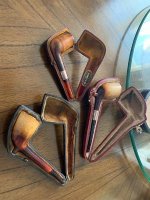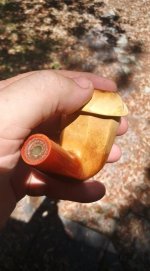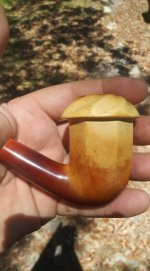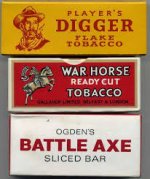I wonder if there is a way to set up some controlled experiments using a shallow dish (or some kind of wick) with a diluted, coloured liquid (maybe even at different temperatures) to check the rate of absorption in the different sections (bowl vs. shank, etc.)View attachment 151955View attachment 151956
The darkest areas weren't even exposed to smoke in the airway. Apologies for not being a clean cut. Did it with a wood cutting blade on a pocket knife.
Coloring Progress Over Time/No of Bowls in one Meerschaum Pipe
- Thread starter cshubhra
- Start date
You are using an out of date browser. It may not display this or other websites correctly.
You should upgrade or use an alternative browser.
You should upgrade or use an alternative browser.
SmokingPipes.com Updates
Watch for Updates Twice a Week
Doubt anyone can or would do that, nor what it would prove.... except more discussion!
I suppose one could fill the chamber part way with strong hot tea..... repeating frequently. Something would happen!
I suppose one could fill the chamber part way with strong hot tea..... repeating frequently. Something would happen!
Thought of that, the same way they fake old parchment documents, stain the the new parchment with tea. Yet the best you could hope for Woolf be a very light tan which I’d why cra-yolas are superiorDoubt anyone can or would do that, nor what it would prove.... except more discussion!
I suppose one could fill the chamber part way with strong hot tea..... repeating frequently. Something would happen!
When my support of cobs was gone, I threw them all away. The rims on all of my cobs at the time were coated with diluted chocolate syrup and cooked on with a lighter.CHambers,how did you checked out the internal coloring on that MM reverse calabash cob?looks like a bowl colored nicely from the outside
Yes, and one other telling detail worth pointing out that I don't think has yet been emphasized: it's not just that the coloring is concentrated in the shank first, but in my experience the underside of the shank is always considerably darker.Seems a bit obvious the heel and shank experience the deep coloring first due to that being the area where moisture would gather.
Surely you were aware we're all nuts long before encountering this thread.What an utterly bizarre thread! Lol
After reading through 7 pages of nothingness I reckon you're all nuts. Get a grip chaps, FFS!!?
I have seen an old antique colored meerschaum pipe and it was chiped away at some small area and it was white under neath
@Chasing Embers : IR camera. I was just pondering that thought myself. To the gentlemen who mentioned coloring bowls you can take a trip over to my infrequently updated blog 'All Things Cutty' and take a look at what the Victorians used for 'Coloring Bowls' back in the 19th century that I have had to yank out of 'cutty' pipes before having them re-stemmed. This starting to have a 'Ground Hog Day' feel about this thread.
I have a Sony video camera with IR.Anybody got an IR camera?
I have written on here before about how the Victorians used to put a silver Six Pence coin drilled with a few holes into the bottom of a meerschaum pipe. This would cause tars and moisture to collect at the bottom of the bowl and in time cause the pipe to color. The bowl would turn brown below the level of the coin and then spread up the shank. If you use Philt Pads or one of the Victorian half marble restrictors as I use then the shank starts to color from the stop by the bone tenon insert. It takes time as all the shit has to be absorbed by the meerschaum. Here are a batch of modern day Six Pence coins since I have found a 1 Euro Cent coin is about the same size.


A lot has been said on this topic. Here are my thoughts on how a Meerschaum colors
1. Meerschaum is super absorbent - So it is logical it should color from both inside and outside
2. Coloring from outside is obstructed by the wax - which acts as a partial barrier
3. The tobacco and the carbon build up also acts as a partial obstruction for coloring from inside
4. Point 2 and 3 above explains why the shank colors first - It is the place with least amount of obstruction
5. Point 2 and 3 also explains why condorlover’s coloring disk and coloring bowls work - They create an air pocket where carbon does not build up and tobacco is not there to obstruct the absorption
6. Internal airway would absorb most of the tar condensation- While meerschaum also colors from outside the amount absorbed is extremely small
7. Collected tars are liquids and it would move in the lattice through capillary action. This movement is extremely slow
8. Capillary movement would also be across a thermal gradient due to changes in surface tension. This would explain partially colored meerschaum losing color when not smoked for some time. The rate of movement across a thermal gradient is faster than a normal movement. This is also where my conjecture/theory is weak.
9. Points 6, 7, 8 above along with the fact that bowl absorbs least amount of tar (Also explained above) why the bowl colors extremely slowly
10. Beeswax by itself I don’t think discolors, but it is a possibility beeswax can absorb tar as well and get colored
11. There was a science teacher who was a member here - He had a theory that wax changes the refractive properties of the surface, making it brighter. That is an extremely plausible theory and can explain some of the initial color of the stem
12. I have a stone ashtray which would collect tars (Which it cannot absorb) - The tar is deep brown in color - This color mixed with the pristine white of the meerschaum would also explain all the stages of meerschaum colors - Pale yellow to deep plummy black based on how much tar the meerschaum has absorbed
13. If you see the cut section of Chasing Embers pipe - It is clear it has absorbed some tar from the surface - The surface color is a couple of mm thick
1. Meerschaum is super absorbent - So it is logical it should color from both inside and outside
2. Coloring from outside is obstructed by the wax - which acts as a partial barrier
3. The tobacco and the carbon build up also acts as a partial obstruction for coloring from inside
4. Point 2 and 3 above explains why the shank colors first - It is the place with least amount of obstruction
5. Point 2 and 3 also explains why condorlover’s coloring disk and coloring bowls work - They create an air pocket where carbon does not build up and tobacco is not there to obstruct the absorption
6. Internal airway would absorb most of the tar condensation- While meerschaum also colors from outside the amount absorbed is extremely small
7. Collected tars are liquids and it would move in the lattice through capillary action. This movement is extremely slow
8. Capillary movement would also be across a thermal gradient due to changes in surface tension. This would explain partially colored meerschaum losing color when not smoked for some time. The rate of movement across a thermal gradient is faster than a normal movement. This is also where my conjecture/theory is weak.
9. Points 6, 7, 8 above along with the fact that bowl absorbs least amount of tar (Also explained above) why the bowl colors extremely slowly
10. Beeswax by itself I don’t think discolors, but it is a possibility beeswax can absorb tar as well and get colored
11. There was a science teacher who was a member here - He had a theory that wax changes the refractive properties of the surface, making it brighter. That is an extremely plausible theory and can explain some of the initial color of the stem
12. I have a stone ashtray which would collect tars (Which it cannot absorb) - The tar is deep brown in color - This color mixed with the pristine white of the meerschaum would also explain all the stages of meerschaum colors - Pale yellow to deep plummy black based on how much tar the meerschaum has absorbed
13. If you see the cut section of Chasing Embers pipe - It is clear it has absorbed some tar from the surface - The surface color is a couple of mm thick
My meers are quickly becoming my favorite pipes. But anyone who knows me, knows how hard it is to not build cake. It's honestly a very wierd concept for me. But it makes sense with a meer. Can't absorb it if there's a 1/4" wall blocking it.Seems a bit obvious the heel and shank experience the deep coloring first due to that being the area where moisture would gather. It also seems obvious the deep coloring isn't the result of heat or the bowl would color first and darkest. I would speculate the cake in the bowl inhibits the moisture leeching through the walls.
Here are a few examples I have selected to not only illustrate the point made by Duane but to hopefully inject some context into the conversation without having to circumcise any ancient meerschaum pipes! The top pipe or the one that appears at 12 o'clock in the picture has been aggressively smoked since the 1900s. You can see that the base of the bowl has changed color as per Duane's comments and that coloring has started to fade since I don't really smoke this pipe very often. Note the line in the bowl which shows the point at which silver coin sat before I ejected it out of the pipe. The pipe on the right hand side is from my regular rotation and I use a coin restrictor in the base. If you go back a few pages you will see it in a group meerschaum picture from 2014/15 showing very little in the way of color. After five plus years of smoking Warrior Plug it has changed to the typical sh*t brown color. The pipe has turned from the base of the pipe all the way up the shank and you can see where the coin sits in the base of the bowl. The final pipe known as one of the 'Jack the Ripper' pipes has been smoked but without a restrictor as far as I can tell and due to its historical value does not get smoked that often but shows again natural coloring through tar absorption. The pipes all date from the mid 1880s through to 1905 or thereabouts.


Very interesting....The most beautifuly colored pipe out of 3 is the Jack the Ripper pipe..If smoked likely without a restrictor it proofs that pipe can color without it nicely...or did he wipe the blood of the victims on it and waxed it in?it is starting to get a little creepy..if it really is one of his pipes you must be very proud to own such a rare historical artifact...Here are a few examples I have selected to not only illustrate the point made by Duane but to hopefully inject some context into the conversation without having to circumcise any ancient meerschaum pipes! The top pipe or the one that appears at 12 o'clock in the picture has been aggressively smoked since the 1900s. You can see that the base of the bowl has changed color as per Duane's comments and that coloring has started to fade since I don't really smoke this pipe very often. Note the line in the bowl which shows the point at which silver coin sat before I ejected it out of the pipe. The pipe on the right hand side is from my regular rotation and I use a coin restrictor in the base. If you go back a few pages you will see it in a group meerschaum picture from 2014/15 showing very little in the way of color. After five plus years of smoking Warrior Plug it has changed to the typical sh*t brown color. The pipe has turned from the base of the pipe all the way up the shank and you can see where the coin sits in the base of the bowl. The final pipe known as one of the 'Jack the Ripper' pipes has been smoked but without a restrictor as far as I can tell and due to its historical value does not get smoked that often but shows again natural coloring through tar absorption. The pipes all date from the mid 1880s through to 1905 or thereabouts.
View attachment 152205
??????????It belonged to one of the Detectives who investigated the Whitechapel Murders - if it had belonged to the 'Ripper' we would have known his identity. Maybe if he did smoke a pipe his preferred blend was Battle Axe...
View attachment 152220
Or perhaps Jack knife plug?It belonged to one of the Detectives who investigated the Whitechapel Murders - if it had belonged to the 'Ripper' we would have known his identity. Maybe if he did smoke a pipe his preferred blend was Battle Axe...
View attachment 152220
I'm relieved to know you didn't inherit it.It belonged to one of the Detectives who investigated the Whitechapel Murders










